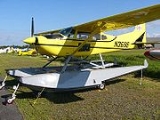
Cessna 185
Encyclopedia
Specification for differing configurations
| Landplane | Floatplane | Amphibian | |
|---|---|---|---|
| Length | 27 ft 0 in (8.23 m) | 27 ft 6 in (8.38 m) | |
| Height | 12 ft 2 in (3.71 m) | 12 ft 8 in (3.86 m) | |
| Empty weight | 1,745 lb (792 kg) | 1,910 lb (866 kg) | 2,165 lb (982 kg) |
| MTOW Maximum Take-Off Weight The Maximum Takeoff Weight or Maximum Takeoff Mass of an aircraft is the maximum weight at which the pilot of the aircraft is allowed to attempt to take off, due to structural or other limits. The analogous term for rockets is Gross Lift-Off Mass, or GLOW... |
3,320 lb (1,506 kg) | 3,265 lb (1,481 kg) on land 3,100 lb (1,406 kg) on water |
|
| Max. speed VNO VNO may mean:* Vomeronasal organ, an auxiliary olfactory sense organ in some tetrapods* VNO speed, the maximum safe cruise speed of an aircraft* The IATA airport code for Vilnius International Airport* The stock symbol for Vornado Realty Trust... |
136 knots (252 km/h) | 141 knots (261 km/h) | 135 knots (251 km/h) |
| Range Range (aircraft) The maximal total range is the distance an aircraft can fly between takeoff and landing, as limited by fuel capacity in powered aircraft, or cross-country speed and environmental conditions in unpowered aircraft.... |
516 nm (957 km) | 503 nm (933 km) | 482 nm (893 km) |
| Service ceiling Service ceiling With respect to aircraft, a ceiling is the maximum density altitude an aircraft can reach under a set of conditions.The word ceiling can also refer to the height of the lowest obscuring cloud layer above the ground.-Service ceiling:... |
16,400 ft (5,000 m) | 15,300 ft (4,700 m) | |
| Rate of climb Rate of climb In aeronautics, the rate of climb is an aircraft's vertical speed - the rate of change in altitude. In most ICAO member countries , this is usually expressed in feet per minute and can be abbreviated as ft/min. Elsewhere, it is commonly expressed in metres per second, abbreviated as m/s... |
960 ft/min (293 m/min) | 970 ft/min (296 m/min) | |
| Wing loading Wing loading In aerodynamics, wing loading is the loaded weight of the aircraft divided by the area of the wing. The faster an aircraft flies, the more lift is produced by each unit area of wing, so a smaller wing can carry the same weight in level flight, operating at a higher wing loading. Correspondingly,... |
19.1 lb/ft² (93.3 kg/m²) | 18.8 lb/ft² (91.8 kg/m²) | |

